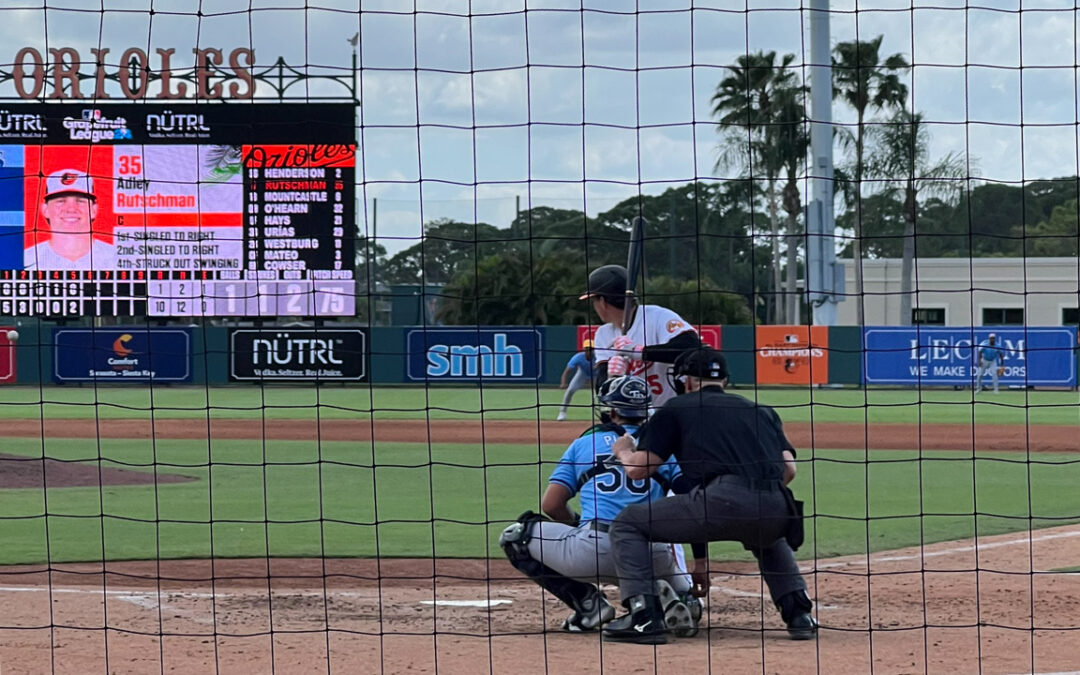Several weeks ago, my son and I went to Orioles spring training in Sarasota. I was careful to take lots of pictures, but after our last game it was odd how my thoughts unexpectedly returned to a trip I had taken earlier this spring. I was on a tour that followed where civil rights activists had marched 60 years ago from Selma to Montgomery, Alabama in March of 1965, where they were mercilessly beaten as they tried to cross the Edmund Pettus Bridge.
This abrupt transition probably did not take place for the reasons that you may imagine.
The Orioles played well and won most of the games that we attended. No, it was something other than that.
It was about living rather than photographing life, and what gets lost and what gets saved.
The Ed Smith Stadium, where the Orioles are encamped for spring training, holds less than 7,500 people. It is like watching Little League compared to Oriole Park in Camden Yards in Baltimore, which seats about 46,000.
The ushers that take you to your seats are all Baltimore retirees, snowbirds bright with their orange uniforms and big smiles. It is magical. The team prepares for the future in a library of memories in the Florida sun.
Our first game, we sat behind home plate and watched the field being lined as the seats filled up around us. It reminded me of when my children were young and we would go to minor league games in Frederick, or even to see the Bowie Bay Sox.
I’ve got the pictures to prove it.
Sitting behind home plate in the afternoon sun, we were up so close we could see how a 90-mile-an-hour fastball looked and sounded when it snapped into place in the catcher’s mitt.
The second game we were behind the Orioles’ dugout. You could see the faces of the players and read their expressions in a way that big league baseball cannot reveal on TV. The cell phones were all focused and the cameras were taking pictures.
Every other day, when the Orioles were traveling, we went to the beach. It was worthless to try to photograph and capture the enormity of going to the beach. The sand was bedroom slipper soft, and the sky was bright blue and huge. Shore birds flocked and fought for food scraps as people packed up, left the beach and went home. You just had to experience it with the sound of the waves and the bickering of the birds.
A photograph could not have captured the environment for memory. Without context, it was all too big and undefined to be described.
The night before we went home, we chose seats by the left field fence at the foul line.
We sat next to a young boy who desperately wanted to catch a baseball in his glove, which he kept squeezing and squeezing to our left. My son, who is a college football coach and had been a fourth-grade teacher, knows and loves kids this age.
As the players warmed up in left field between innings, we all got into the act as the players warmed up. We all were trying to get a player to give the young boy a baseball.
My son was quiet for a while until he encouraged the boy to get the ball himself. The boy’s older brother and father grew suspicious. My son encouraged the boy to leave the rest of us behind and go past the left field foul line to where the bullpen was located. There, he could watch the catcher and pitching coach as they were warming up the relievers between innings.
The boy went off on his own but we all could see the interaction between that determined young boy and that aging catcher and pitching coach because it was palpable, but still professional.
On his own, the boy built up his courage and made distant contact with the catcher and ultimately, at the end of the game, the catcher handed the pitching coach a ball, pointed at the boy, and the pitching coach went over and delivered the ball to him. All this was watched with bemused approval and excitement by the local crowd who had followed the little drama.
As we were walking back to the car after the game was over, I chastised myself for not taking pictures as the little story evolved. I remember the amazing joy on that boy’s face as he pounded and re-pounded the ball in his glove as he said goodbye and we went our different ways.
I remember from my tour reading the history of the march from Selma as I started across the bridge and over the brown river with its high banks, which I photographed excessively until I stopped midway across the bridge.
All the photographs I had taken were of a bridge before spring, where there was little life along the shoreline up and down the river. All of a sudden, I stopped photographing, and just looked and felt the river flowing beneath me. I imagined what the crowd must’ve felt with the locals and their law enforcement ready to beat the daylights out of the marchers if they moved a step further and they did.
I go over those photographs now, and I don’t catch the event the way I remembered it by looking at it and avoiding the photograph. I feel the same way about seeing that boy pounding that ball in his glove and smiling as we parted. Without context, it was all too big and undefined to be described. The memory may fade, but because I didn’t take the photograph, I saw it and the experience is still alive in me.

